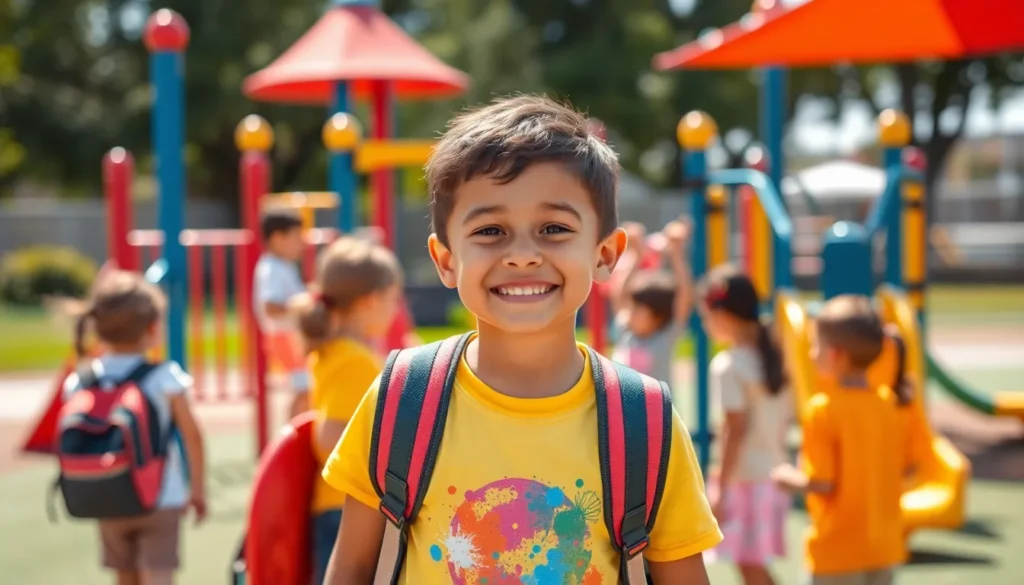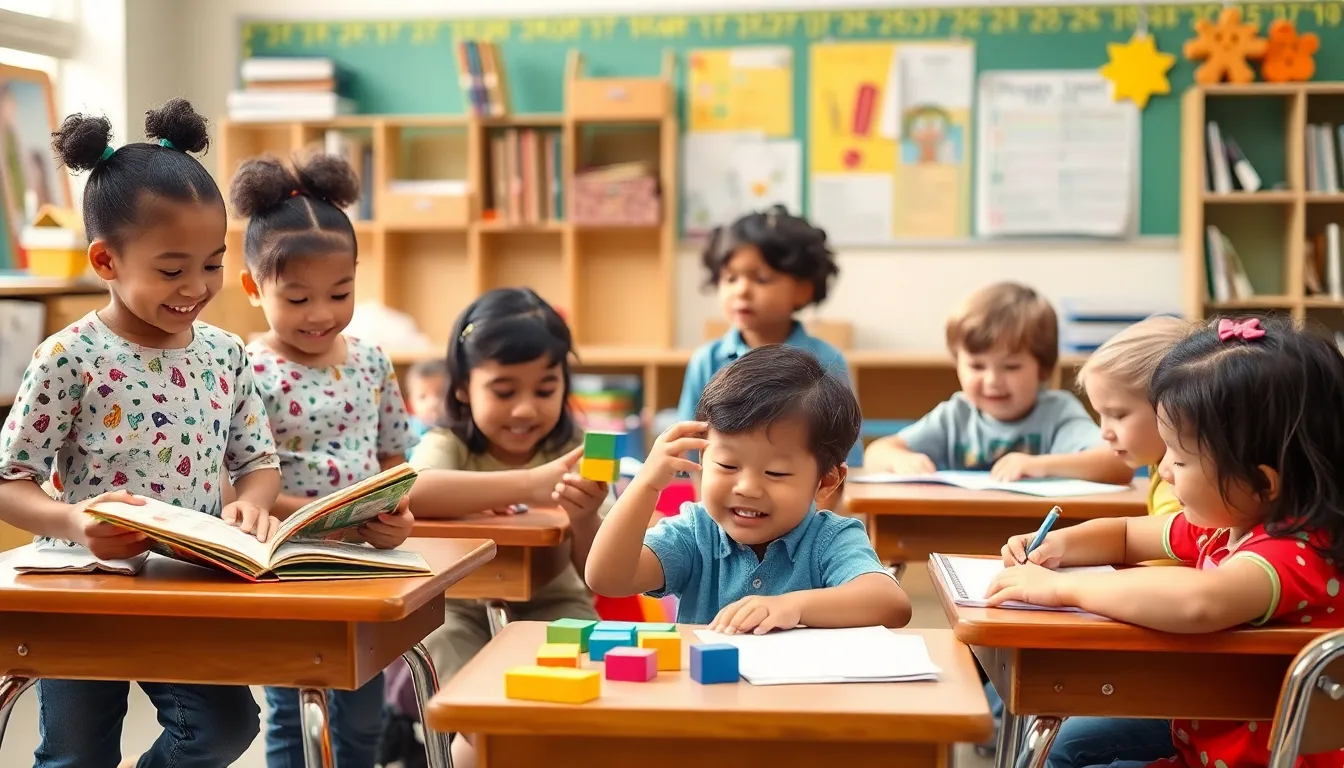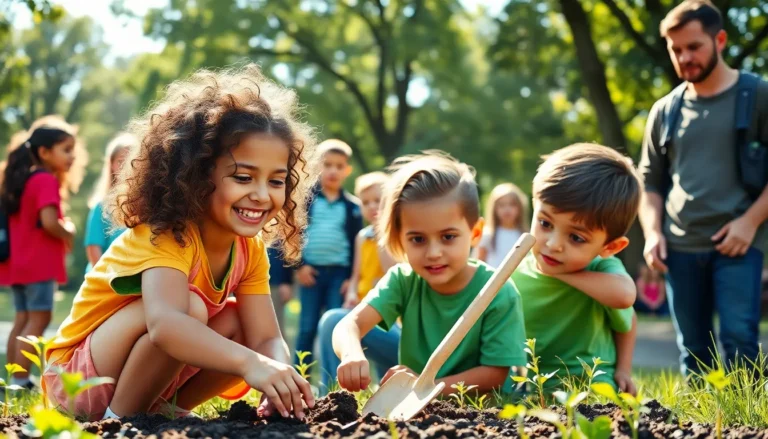As summer fades and the school bells start ringing, the thought of first grade readiness can send shivers down the spines of parents everywhere. It’s like preparing for a high-stakes game of dodgeball—except the dodgeballs are math problems and reading assignments. But fear not! First grade is not just about academics; it’s a thrilling adventure where kids discover their passions and make lifelong friends.
Understanding First Grade Readiness
First grade readiness involves a child’s ability to transition smoothly into first grade. This readiness encompasses various skills, including social, emotional, cognitive, and physical development.
Definition of First Grade Readiness
First grade readiness refers to a child’s preparedness to tackle first grade’s academic and social demands. Assessments typically measure skills like recognizing letters, understanding basic math concepts, and demonstrating effective communication. Children also show readiness through consistent emotional regulation and social interaction, which encourages positive classroom experiences. Successful preparation contributes to a child’s confidence and ability to engage in learning.
Importance of Readiness in Education
Readiness plays a crucial role in a child’s educational journey. Strong foundational skills lead to improved academic performance in first grade and beyond. Children who display readiness often experience less anxiety, making them more open to learning new concepts. Early childhood education emphasizes the significance of readiness, as it can impact long-term academic achievement. Additionally, understanding readiness allows educators and parents to tailor support for each child’s unique needs, fostering a productive learning environment.
Key Indicators of First Grade Readiness
Understanding the critical indicators of first grade readiness helps parents and educators prepare children for this significant transition. These indicators span across academic, social and emotional, and physical domains.
Academic Skills
Children entering first grade should demonstrate foundational academic skills. Letter recognition is essential, as it supports reading fluency. Many children also benefit from a grasp of basic math concepts like counting and simple addition or subtraction. Engaging with numbers in everyday contexts, such as counting toys, bolsters mathematical understanding. Communication skills should also be evident. Expressing thoughts clearly and listening attentively fosters successful classroom interactions. Children displaying these academic abilities experience less anxiety and more confidence in their capability to learn.
Social and Emotional Skills
Social and emotional skills play a vital role in first grade readiness. Children need to show comfort in interacting with peers and adults. Building friendships through shared activities enhances social development. Emotional regulation is equally significant; recognizing feelings and managing them effectively often leads to better behavior in classroom settings. Following directions and cooperating in group tasks prepare students for collaborative learning environments. Enthusiasm for new experiences contributes to a positive attitude toward learning.
Physical Development
Physical development influences a child’s readiness for first grade. Fine motor skills should include basic writing, cutting with scissors, and manipulating small objects. Participation in activities that enhance hand-eye coordination supports overall readiness. Gross motor skills are equally important; running, jumping, and climbing help children navigate the physical demands of a school environment. Adequate stamina for following daily routines fits into this category as well. Children who possess these physical skills find it easier to engage in classroom activities and participate in play.
Strategies to Support First Grade Readiness
Supporting first grade readiness involves various strategies that enhance a child’s learning and development. Focus on engaging activities, boosting social skills, and fostering emotional strength.
Engaging Learning Activities
Incorporate fun educational activities into daily routines. Use games that promote math skills, like counting objects during playtime. Encourage reading through interactive storytelling, allowing children to explore their imagination. Craft projects enhance fine motor skills, making activities like cutting and gluing both enjoyable and beneficial. Ensure variety in learning modes, combining visual, auditory, and kinesthetic experiences for maximum engagement.
Encouraging Social Interaction
Create opportunities for children to interact with peers. Organize playdates or group activities to facilitate friendships. Involve them in team sports, promoting cooperation and teamwork. Foster family gatherings that build social skills through shared experiences. Encourage participation in community events, allowing exposure to diverse social settings. Each interaction strengthens a child’s ability to navigate relationships and express themselves comfortably.
Building Emotional Resilience
Cultivate emotional resilience through supportive environments. Teach children to identify and express their feelings effectively. Encourage problem-solving discussions, allowing them to navigate conflicts constructively. Celebrate small successes to build a sense of accomplishment and boost confidence. Provide a consistent routine as it offers security, helping kids manage anxieties about new experiences. Strengthening emotional tools prepares them for the challenges of first grade.
Resources for Parents and Educators
Parents and educators can access a variety of resources to enhance first grade readiness. These tools help foster essential skills in children, preparing them for a successful transition.
Recommended Books and Materials
Books serve as valuable resources for developing literacy and numeracy. Titles like “The Very Hungry Caterpillar” by Eric Carle introduce concepts of counting and days of the week. “Chicka Chicka Boom Boom” by Bill Martin Jr. engages children with letter recognition through rhythmic storytelling. Additionally, materials such as alphabet puzzles and math workbooks reinforce basic skills. Parents and educators can also explore reading programs designed for first graders, including leveled readers that align with individual learning levels.
Online Tools and Programs
Online platforms offer a variety of interactive programs that support learning. Websites like ABCmouse provide comprehensive learning experiences covering literacy, math, and science for early learners. Starfall focuses on phonics and reading comprehension, making it engaging for children. Additionally, apps such as Endless Alphabet introduce vocabulary in fun ways. Many of these resources include progress tracking features, allowing parents and educators to monitor development effectively.
Conclusion
Preparing for first grade can feel overwhelming for both parents and children. However it’s important to remember that this transition is a significant milestone filled with opportunities for growth and discovery. By focusing on readiness indicators across academic social emotional and physical domains parents can help their children thrive in this new environment.
Engaging in fun learning activities fostering social interactions and building emotional resilience will ease the transition and enhance a child’s confidence. With the right support and resources children can embrace first grade with excitement and curiosity paving the way for a successful educational journey ahead.







